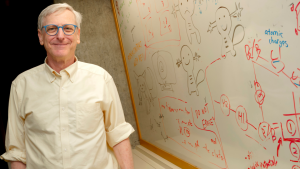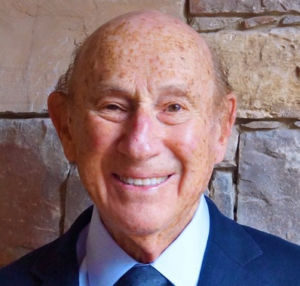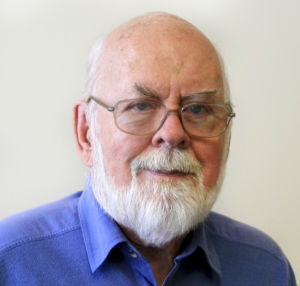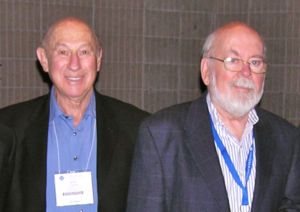The 2025 Pariser-Parr Lectureship
October 9, 2025
12:30 pm in Murray G202
The Pariser and Parr families established the annual Pariser-Parr Lecture to bring leading scientists to UNC so that UNC students have an opportunity to learn about cutting-edge theoretical chemistry research they may not otherwise have a chance to hear about.
We thank them for their generosity, and look forward to many more lectures in honor of Dr. Pariser and Professor Parr for their groundbreaking work and lifelong friendship.
Lecturer
David N. Beratan, PhD
 R.J. Reynolds Professor of Chemistry at Duke University, with joint appointments in Biochemistry and Physics. He earned his BS in Chemistry from Duke and PhD in Chemistry from the California Institute of Technology. David was a National Research Council Resident Research Associate at Caltech’s Jet Propulsion Laboratory and a Member of the Technical Staff. He began his academic career at the University of Pittsburgh and moved to Duke in 2001, where he has served as Department Chair. David is a Fellow of the American Chemical Society, American Physical Society, American Association for the Advancement of Science, and Royal Society of Chemistry. He was a J.S. Guggenheim Foundation Fellow, a Visiting Fellow at All Souls College (Oxford), a Ralph and Lucy Hirschmann Visiting Professor at the University of Pennsylvania, and a Conrad E. Ronneberg Visiting Scholar at the University of Chicago. David won the Herty, Florida, Goodman, Morley and Langmuir Awards from the American Chemical Society, the Horizon and Bourke Awards from the Royal Society of Chemistry, the Feynman Prize for Nanoscience from the Foresight Institute, and the Cozzarelli Prize from Proceedings of the National Academy of Sciences. He is a member of the National Academy of Sciences and the International Academy of Quantum Molecular Science.
R.J. Reynolds Professor of Chemistry at Duke University, with joint appointments in Biochemistry and Physics. He earned his BS in Chemistry from Duke and PhD in Chemistry from the California Institute of Technology. David was a National Research Council Resident Research Associate at Caltech’s Jet Propulsion Laboratory and a Member of the Technical Staff. He began his academic career at the University of Pittsburgh and moved to Duke in 2001, where he has served as Department Chair. David is a Fellow of the American Chemical Society, American Physical Society, American Association for the Advancement of Science, and Royal Society of Chemistry. He was a J.S. Guggenheim Foundation Fellow, a Visiting Fellow at All Souls College (Oxford), a Ralph and Lucy Hirschmann Visiting Professor at the University of Pennsylvania, and a Conrad E. Ronneberg Visiting Scholar at the University of Chicago. David won the Herty, Florida, Goodman, Morley and Langmuir Awards from the American Chemical Society, the Horizon and Bourke Awards from the Royal Society of Chemistry, the Feynman Prize for Nanoscience from the Foresight Institute, and the Cozzarelli Prize from Proceedings of the National Academy of Sciences. He is a member of the National Academy of Sciences and the International Academy of Quantum Molecular Science.
Dr. Beratan studies the physical origins of function in molecules and molecular assemblies, especially structures that underpin energy transduction in living systems. He also develops strategies to optimize the properties of functional structures. David contributed to the development of “pathway” models for: electron tunneling, hopping, bifurcation, and flickering resonance transport in biological macromolecules. He also helped to establish coupling pathway models for Dexter mechanism electronic energy transport and infra-red gated electron transport. He established strategies to optimize the non-linear electronic response of organic structures and to assign the absolute stereochemistries of natural products through the computation of chiroptical properties; he helped to establish the concepts of chiral imprinting and of inverse molecular design. David’s ongoing studies focus on: the molecular mechanisms of electron bifurcation reactions in biological and bioinspired structures, charge transport over micrometer to centimeter distances in living systems, the physical origins of spin filtering in chiral structures, triplet exciton transport, and the design of de novo proteins with novel redox function.
Dr. Rudolph Pariser

Dr. Pariser, aware of Professor Parr’s thesis on quantum calculations of benzene, brought him on as a consultant to help compute spectra of complex dyes. Early in their collaboration, Parr introduced the “Zero Differential Overlap Approximation,” which greatly simplified calculations and reproduced his benzene results efficiently. To align with experimental data, Pariser adjusted inter-electronic repulsion integrals using atomic ionization potentials and electron affinities.
Using IBM’s transistorized 701 supercomputer, Pariser wrote a machine-language program to perform these calculations. His results for polyacenes—from Naphthalene to Pentacene—closely matched experimental values and predicted new excited states, such as triplet states, which were later confirmed.
With later contributions from John Pople, the method became known as the Pariser-Parr-Pople (PPP) theory. It remains widely used in theoretical chemistry today.
Dr. Robert G. Parr

Professor Parr was a pioneer the field of ab initio quantum chemistry since the 1950’s. His book entitled Quantum Theory of Molecular Electronic Structure, Benjamin 1963, was most influential at that time.
Parr constructed the zero-differential overlap approximation and later, with Pariser and added by Pople, developed the influential Pariser-Parr-Pople, PPP, method. The PPP method was a landmark in the development of quantum chemistry and is still very widely used.
In the early seventies, Parr had the vision to realize that density-functional theory, DFT, could very well turn out to be the method of choice for quantitative calculations on systems of chemical and biological interest, especially for those with large numbers of electrons. Parr had the foresight to begin his research in DFT long before it was as popular or as fashionable as it is today in the chemistry community. In fact, for years Parr was virtually the only chemist of his generation to pursue DFT. He had the courage to do this despite the fact that he was often criticized, and even ridiculed at times, for it.
Past Lecturers
2024 Todd Martinez (Stanford University)
2023 Christopher Jarzynski (University of Maryland, College Park)
2022 Giulia Galli (University of Chicago)
2021 Not held due to Covid
2020 Not held due to Covid
2019 John Weeks (University of Maryland, College Park)
2018 Jeffrey Neaton (University of California at Berkeley and Lawrence Berkeley National Laboratory )
2017 Arieh Warshel (University of Southern California)
2016 Geraldine Richmond (University of Oregon)
2015 Martin Head-Gordon (University of California at Berkeley)
2014 Weitao Yang (Duke University)


